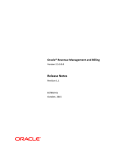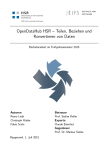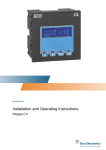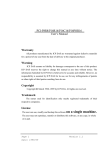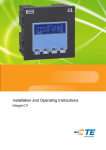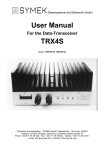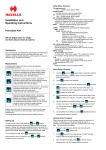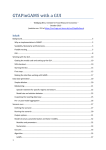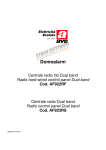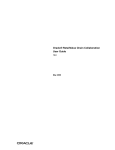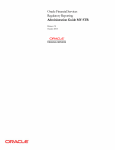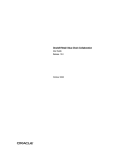Download Release Notes - Oracle Documentation
Transcript
Oracle® Revenue Management and Billing Version 2.3.0.1.0 Release Notes E55302-01 August, 2014 Oracle Revenue Management and Billing Release Notes Oracle Revenue Management and Billing Version 2.3.0.1.0 Release Notes E55302-01 Copyright Notice Copyright © 2014, Oracle and/or its affiliates. All rights reserved. Trademark Notice Oracle and Java are registered trademarks of Oracle Corporation and/or its affiliates. Other names may be trademarks of their respective owners. Intel and Intel Xeon are trademarks or registered trademarks of Intel Corporation. All SPARC trademarks are used under license and are trademarks or registered trademarks of SPARC International, Inc. AMD, Opteron, the AMD logo, and the AMD Opteron logo are trademarks or registered trademarks of Advanced Micro Devices. UNIX is a registered trademark of The Open Group. License Restrictions Warranty/Consequential Damages Disclaimer This software and related documentation are provided under a license agreement containing restrictions on use and disclosure, and are protected by intellectual property laws. Except as expressly permitted in your license agreement or allowed by law, you may not use, copy, reproduce, translate, broadcast, modify, license, transmit, distribute, exhibit, perform, publish, or display any part, in any form, or by any means. Reverse engineering, disassembly, or de-compilation of this software, unless required by law for interoperability, is prohibited. Warranty Disclaimer The information contained herein is subject to change without notice and is not warranted to be errorfree. If you find any errors, please report them to us in writing. Restricted Rights Notice If this software or related documentation is delivered to the U.S. Government or anyone licensing it on behalf of the U.S. Government, the following notice is applicable: U.S. GOVERNMENT RIGHTS Oracle programs, including any operating system, integrated software, any programs installed on the hardware and/or documentation delivered to U.S. Government end users are “commercial computer software” pursuant to the applicable Federal Acquisition Regulation and agency-specific supplemental regulations. As such, use, duplication, disclosure, modification, and adaptation of the programs, including any operating system, integrated software, any programs installed on the hardware and/or documentation shall be subject to license terms and restrictions applicable to the programs. No other rights are granted to the U.S. Government. Hazardous Applications Notice This software is developed for general use in a variety of information management applications. It is not developed or intended for use in any inherently dangerous applications, including applications that may ii Copyright © 2014, Oracle and/or its affiliates. All rights reserved. Oracle Revenue Management and Billing Release Notes create a risk of personal injury. If you use this software in dangerous applications, then you shall be responsible to take all appropriate fail-safe, backup, redundancy, and other measures to ensure the safe use of this software. Oracle Corporation and its affiliates disclaim any liability for any damages caused by use of this software in dangerous applications. Third Party Content, Products, and Services Disclaimer This software and documentation may provide access to or information on content, products, and services from third parties. Oracle Corporation and its affiliates are not responsible for and expressly disclaim all warranties of any kind with respect to third party content, products, and services. Oracle Corporation and its affiliates will not be responsible for any loss, costs, or damages incurred due to your access to or use of third party content, products, or services. Copyright © 2014, Oracle and/or its affiliates. All rights reserved. iii Oracle Revenue Management and Billing Release Notes About this Document This document describes the enhancements made in this release. It indicates the changes made to the existing screens in Oracle Revenue Management and Billing. It also highlights the bug fixes and known issues in this release. This document does not describe the functionality of Oracle Revenue Management and Billing or technical know-how on how to install or upgrade Oracle Revenue Management and Billing. For more detailed information, you can refer to the following documents: Document Description Oracle Revenue Management and Billing Lists and describes various banking features in Oracle Banking User Guide Revenue Management and Billing. It also describes all screens related to these features and explains how to perform various tasks in the application. Oracle Revenue Management and Billing Lists and describes various insurance features in Oracle Insurance User Guide Revenue Management and Billing. It also describes all screens related to these features and explains how to perform various tasks in the application. Oracle Revenue Management and Billing Lists the pre-requisites, supported platforms, and Installation Guide hardware and software requirements for installing the Oracle Revenue Management and Billing application. It also explains how to install the Oracle Revenue Management and Billing application. Oracle Revenue Management and Billing Provides high-level information on how to install the Quick Installation Guide Oracle Revenue Management and Billing application. Oracle Revenue Management and Billing Provides detailed information on how to install the Database Administrator's Guide database for the Oracle Revenue Management and Billing application. ORMB-Documaker Integration Guide for Provides detailed information on how to integrate Oracle Banking Documaker with Oracle Revenue Management and Billing so that you can use Oracle Documaker for the Banking module. ORMB-Documaker Integration Guide for Provides detailed information on how to integrate Oracle Insurance Documaker with Oracle Revenue Management and Billing so that you can use Oracle Documaker for the Insurance module. ORMB - Transaction Feed Management - Describes the sequence in which the batches must be Batch Execution Guide executed while performing various tasks in the Transaction Feed Management module. iv Copyright © 2014, Oracle and/or its affiliates. All rights reserved. Oracle Revenue Management and Billing Release Notes Document ORMB Billing - Batch Execution Guide Description Describes the batches that you can use for generating bills in Oracle Revenue Management and Billing. Oracle Revenue Management and Billing Describes the Oracle Revenue Management and Billing Server Administration Guide architecture. It also explains how to configure, deploy, and monitor web and business application servers. Oracle Revenue Management and Billing Provides detailed information on how to configure and Batch Server Administration Guide work with the batch component in Oracle Revenue Management and Billing. Oracle Revenue Management and Billing Describes how to configure security for the Oracle Security Guide Revenue Management and Billing application using the default security features. Oracle Revenue Management and Billing Explains how to upgrade the Oracle Revenue Management Upgrade Guide and Billing framework, application, and its database. Oracle Revenue Management and Billing Explains the path and pre-requisites for upgrading Oracle Upgrade Path Guide Revenue Management and Billing from one version to another. Oracle Revenue Management and Billing Explains the sample pages available in the Self Service Self Service Guide application and how to customize these pages as per the customer’s requirements. Oracle Revenue Management and Billing Explains how to install and configure the Self Service Self Service Installation and Configuration application. Guide Oracle Revenue Management and Billing Explains how to install reports in Oracle BI Publisher and Reports Installation Guide ORMB. It also explains how to create new reports from scratch or using the sample report as a starting point. Copyright © 2014, Oracle and/or its affiliates. All rights reserved. v Oracle Revenue Management and Billing Release Notes Contents Prerequisites .....................................................................................................................................1 New Features.....................................................................................................................................2 Enhancements ...................................................................................................................................3 Transaction Feed Management ................................................................................................................ 3 Billing ......................................................................................................................................................... 7 Pricing Management ................................................................................................................................. 9 Payments................................................................................................................................................. 10 On Demand Billing .................................................................................................................................. 10 Pay Plan ................................................................................................................................................... 12 User Interface (UI) Level Changes ..................................................................................................... 13 Supported Platforms ........................................................................................................................ 16 Technical Recommendations ............................................................................................................ 17 Framework Upgrade ........................................................................................................................ 18 Supported Upgrades ........................................................................................................................ 19 Discontinued Features ..................................................................................................................... 20 Product Documentation ................................................................................................................... 21 Media Pack Download ..................................................................................................................... 22 Bug Fixes ......................................................................................................................................... 23 Known Issues ................................................................................................................................... 28 Banking.................................................................................................................................................... 28 Insurance ................................................................................................................................................. 40 Documentation ....................................................................................................................................... 42 Technical Support ............................................................................................................................ 45 vi Copyright © 2014, Oracle and/or its affiliates. All rights reserved. Oracle Revenue Management and Billing Release Notes Prerequisites If a customer is already using the Transaction Feed Management feature and wants to upgrade to Oracle Revenue Management and Billing Version 2.3.0.1.0, then the customer needs to ensure the following (before upgrading): All bills generated in the system are in the Complete status. In other words, there should not be any bills in the Pending status. If there are any bills in the Pending status or if any billable charge (generated through TFM) is not yet billed, disaggregation and cancellation of transactions which are uploaded using 2.3.0.0.0 will not happen successfully. Transactions which are uploaded using 2.3.0.0.0 must not be in the Initial Product Determined (INPD) status. They can be in the Uploaded (UPLD), Invalid (INVL), Error (EROR), Completed (COMP), or Cancelled (CNCL) status. Equal to (=) or tilde (~) symbol is not used in any existing product parameter code or value. Otherwise, erroneous results might occur. Copyright © 2014, Oracle and/or its affiliates. All rights reserved. 1 Oracle Revenue Management and Billing Release Notes New Features No new features are introduced in this release. 2 Copyright © 2014, Oracle and/or its affiliates. All rights reserved. Oracle Revenue Management and Billing Release Notes Enhancements This section lists the enhancements made to the following features: Transaction Feed Management Billing Pricing Management Payments On Demand Billing Pay Plan Transaction Feed Management The following changes are made to the transaction feed management process: Earlier, the system allowed multiple accounts to bear the charges for a transaction provided these accounts belong to the division to which the transaction belongs. But, now, these accounts can belong to different divisions (and need not belong to the division to which the transaction belongs). Earlier, in the CSV file, if a transaction or any other user defined currency was other than the division’s base currency, the system did the currency conversion if the appropriate exchange rate was available in the system. Now, in the CSV file, if a transaction or any other user defined currency is other than the pricing currency, the system will do the currency conversion if the appropriate exchange rate is available in the system. The status of the transaction will not be changed to Error (EROR) if the base currency is not defined for the division (to which the transaction belongs). The disaggregation process is redesigned to work when the charges for a transaction are borne by multiple accounts. Now, to disaggregate transactions of an account, you need to execute the following batches in the specified order: o Disaggregation Request Creation (C1-DISTG) o Identify Affected Transactions (C1-IAENT) o Process Non Aggregated Transactions (C1-PDTXN) o Clean Up (C1-TXNCU) o Update Disaggregation Request Status (C1-DARSU) The Disaggregation Request Creation (C1-DISTG) batch is optional. You can directly execute the Identify Affected Transactions (C1-IAENT) batch if the disaggregation requests are available in the CI_TXN_DISAGG_REQ table. Copyright © 2014, Oracle and/or its affiliates. All rights reserved. 3 Oracle Revenue Management and Billing 4 Release Notes Earlier, you were able to create a disaggregation request for an account or a customer only through the Disaggregation Request Creation (C1-DISTG) batch. Now, you can also create a disaggregation request for an account or a customer manually through a user interface. A new screen named Disaggregation Request is introduced in the Transaction Feed Management main menu. The Disaggregation (C1-TXNDA) batch is no longer available for disaggregating transactions of an account. You can now define the Processing Date for Transaction Feed Management characteristic for each division. This characteristic is used while executing the following TFM batches: o Transaction Validation and Initial Product Determination (C1-TXNIP) – If the Processing Date for Transaction Feed Management characteristic type of the division (to which the transaction belongs) is set to BATCH_DT, the system executes the rules which are effective on the batch business date. However, if the Processing Date for Transaction Feed Management characteristic type of the division (to which the transaction belongs) is set to TXN_DT, the system executes the rules which are effective on the transaction date. o Product Pricing Verification (C1-TXNVP) - If the Processing Date for Transaction Feed Management characteristic type of the division (to which the account belongs) is set to BATCH_DT, the system searches for the pricing which is effective on the batch business date. However, if the Processing Date for Transaction Feed Management characteristic type of the division (to which the account belongs) is set to TXN_DT, the system searches for the pricing which is effective on the transaction date. o Service Quantity Calculation (C1-TXNSQ) and Clean Up (C1-TXNCU) - If the Processing Date for Transaction Feed Management characteristic type of the division (to which the account belongs) is set to BATCH_DT, the system uses the exchange rate which is effective on the batch business date. However, if the Processing Date for Transaction Feed Management characteristic type of the division (to which the account belongs) is set to TXN_DT, the system uses the exchange rate which is effective on the transaction date. A soft parameter named Pricing Level is removed from the Product Pricing Verification (C1TXNVP) batch. This soft parameter was earlier added to improve batch performance. As the Product Pricing Verification (C1-TXNVP) batch is tuned to provide better performance in this release, the Pricing Level parameter is no longer required. You can now use the Clean Up (C1-TXNCU) batch to: o Delete and update billable charges for transactions which are in the Error (EROR) status o Delete and update billable charges while disaggregating transactions o Delete and update billable charges while cancelling a transaction feed Copyright © 2014, Oracle and/or its affiliates. All rights reserved. Oracle Revenue Management and Billing Release Notes Earlier, the Rule Validation algorithm was used to check whether the values specified against the output parameters exist in the system. Now, it also checks whether the same product parameter (for example, PCD1_1_1_VAL) is not used multiple times for a division, account, and product combination. Earlier, the Parameter Group Creation was a distinct sub-process in TFM. Now, it is a part of the Transaction Validation and Initial Product Determination sub-process. Once the transaction validation, and initial product and parameters mapping is complete, the product parameters to which the transaction is mapped are grouped. A set of product parameters are grouped only when the multi parameter based pricing feature is enabled. The Parameter Group Creation (C1PRMGC) batch is no longer supported from this release onwards. A soft parameter named Disaggregate Transactions From Date is added in the following batches: o Identify Affected Transactions (C1-IAENT) o Process Non Aggregated Transactions (C1-PDTXN) o Clean Up (C1-TXNCU) o Update Disaggregation Request Status (C1-DARSU) The following two soft parameters are added in the Rollback (C1-TXNRB) batch: o Rollback From Date o Rollback To Date The transaction aggregation process is redesigned to enforce the order in which the batches must be executed. Now, o The system allows you to execute each batch consecutively. You can execute the Transaction Validation and Initial Product Determination batch consecutively with the same division and same parameters, or with the different division and different parameters. But, you cannot execute the Transaction Validation and Initial Product Determination (C1-TXNIP) batch consecutively with the same division and different parameters. For example, once you execute this batch with division as D1 and transaction source as S1, you cannot execute this batch again with division as D1 and transaction source as S2. o Once the Product Pricing Verification (C1-TXNVP) batch is executed, you cannot execute the Transaction Validation and Initial Product Determination (C1-TXNIP) batch again with the same division and same parameters unless and until the transaction aggregation cycle is complete. o During the transaction aggregation process, you must specify the same division and same parameters across each batch. Otherwise, erroneous results might occur. o If you have already executed the Transaction Validation and Initial Product Determination (C1-TXNIP) batch without any division, then you cannot execute this Copyright © 2014, Oracle and/or its affiliates. All rights reserved. 5 Oracle Revenue Management and Billing Release Notes batch once again with a division unless and until the transaction aggregation cycle is complete. The following two tables are partitioned based on the CURR_SYS_PRCS_DT primary key: o CI_TXN_DETAIL o CI_TXN_DTL_PRITM Therefore, now, when you execute the Transaction Validation and Initial Product Determination (C1-TXNIP) batch on different dates, a partition is created for each date on the table. For example, when you execute the Transaction Validation and Initial Product Determination (C1-TXNIP) batch on 1st Aug, 2nd Aug, and 3rd Aug, three partitions are created on the table – one for the respective date. But, when you execute the Transaction Validation and Initial Product Determination (C1-TXNIP) batch multiple times (with same and different division and/or parameters) on the same date, the processed data will be on the same partition. All other aggregation batches (such as, C1-TXNVP, C1-TXNEX, C1-TXNSQ, C1-TXNCM, and C1TXNCU) will refer to one or more table partitions and process the data accordingly. If you are executing all batches on 1st Aug, each batch will refer to the 1st Aug partition on the table. But, if you are executing the Transaction Validation and Initial Product Determination (C1-TXNIP) batch on 1st Aug, 2nd Aug, and 3rd Aug and the Product Pricing Verification (C1-TXNVP) batch on 3rd Aug, then the C1-TXNVP batch will process the data available on three partitions - 1st Aug, 2nd Aug, and 3rd Aug. This means that each batch will refer to a range of partitions whose data is not yet processed. Now, the system allows you to cache the product pricing information which can then be used by the Product Pricing Verification (C1-TXNVP) batch. This helps to improve the batch performance. If you set the Materialized View Used option type of the C1_FM feature configuration to true, the system will cache the product pricing information in the following tables: o CI_PRC_AGRD o CI_PRC_PL o CI_PRC_INH_PL But, if you set the Materialized View Used option type of the C1_FM feature configuration to false, the system will not cache the product pricing information. If there are any pricing changes, we have to update this cache before executing the Product Pricing Verification (C1-TXNVP) batch. A batch named Refresh Pricing (C1-TXNRP) is introduced which will help to update the product pricing information in the cache. Ideally, you must execute this batch after you execute the Flush All Caches (F1-FLUSH) batch during the transaction aggregation process. 6 Copyright © 2014, Oracle and/or its affiliates. All rights reserved. Oracle Revenue Management and Billing Release Notes Billing The following changes are made to the billing feature: If a billable charge is generated automatically through the transaction feed management or on demand billing process, you cannot edit the details of the billable charge. You can only cancel the billable charge, if required. The Bill Cycle (BILL-CYC-CD) parameter is added in the Billing (BILLING) batch. It is used when you want to generate bills for accounts having a particular bill cycle. In the BILLING batch, multi-threading is based on Account ID and chunks for multi-threading are created based on numerical distribution of Account ID. This chunking logic might not be efficient while handling voluminous data. To handle high volume with better performance, you must generate bills using the following three batches (in the specified order): 1. Pending Bill Generation (C1-PNDBL) – This batch is used to generate pending bills for accounts that meet the criteria. 2. Bill Segment Generation (C1-BLGEN) – This batch is used to generate the bill segments. 3. Bill Completion (C1-BLPPR) – This batch is used to generate post processing bill segments during the bill completion process and change the status of the bill to Complete. These three are multi-threaded batches. They are primarily designed and developed for the Banking and Payments industries. For more information about these batches, refer to the ORMB Billing - Batch Execution Guide. Initially, you were not able to control the order in which bill segments were generated during the billing process. Now, using the Bill Segment Generation (C1-BLGEN) batch, you can generate bill segments in a particular order of importance. This batch allows you to specify the billing processing sequence of the contract’s contract type whose bill segments you want to generate. You can delete a bill cycle only if it is not associated to any division. There is a change in the logic for calculating the post processing bill segment start and end dates. Now, the system finds the bill segment whose start date is earlier than all other bill segments’ start date in the bill and then considers this date as the post processing bill segment start date. Similarly, the system finds the bill segment whose end date is later than all other bill segments’ end date in the bill and then considers this date as the post processing bill segment end date. Initially, you were able to generate a bill using the billable charges whose start date is earlier than or equal to the cut-off date. Now, you can generate a bill using the billable charges whose start or end date is earlier than or equal to the cut-off date. If you want to consider the billable charges whose start date is earlier than or equal to the cut-off date, you must set the Billable Charges Date option type of the C1_FINTRANOP feature configuration to S. And, if you want to consider the billable charges whose end date is earlier than or equal to the cut-off date, you Copyright © 2014, Oracle and/or its affiliates. All rights reserved. 7 Oracle Revenue Management and Billing Release Notes must set the Billable Charges Date option type of the C1_FINTRANOP feature configuration to E. A new option type named Bill Segment Regeneration on Freeze is added and the Billing Post Processing Option type is removed from the C1_FINTRANOP feature configuration. If you want to regenerate the bill segments before freezing them, you must set the Bill Segment Regeneration on Freeze option type of the C1_FINTRANOP feature configuration to Y. However, if you do not want to regenerate the bill segments before freezing them, you must leave the Bill Segment Regeneration on Freeze option type blank. The Process Only Frozen FTs (FROZEN-FT-SW) parameter is added in the Assign GL Account to Financial Transaction (GLASSIGN) batch. It is used to indicate whether you want to assign GL account only to frozen financial transactions. If you set the value of this parameter to Y, GL account is assigned only to frozen financial transactions. However, if you want to assign GL account to both frozen and freezable financial transactions, you must leave this field blank. In the GLASSIGN batch, multi-threading is based on FT_ID and chunks for multi-threading are created based on numerical distribution of FT_ID. This chunking logic might not be efficient while handling voluminous data. To handle high volume with better performance, you must assign GL account to financial transactions using the following two batches (in the specified order): 1. Insert Records in CI_FTTEMP (GLASSGN1) – This batch is used to search and add the frozen and/or freezable financial transactions (FTs) (where the GL account is not yet assigned) in the CI_FTTEMP table. The data in this table is used for creating chunks for multi-threading. You can specify the following parameters while executing this batch: Parameter Name Mandatory (Yes or Description No) Thread Count No Used to specify the number of threads you want to spawn in parallel. Override Maximum Number of Errors No Used to override the maximum number of errors after which the batch must be terminated. Process Only Frozen FTs No Used to indicate whether you want to assign GL account only to frozen financial transactions. If you set the value of this parameter to Y, GL account is assigned only to frozen financial transactions. However, if you want to assign GL account to both frozen and freezable financial transactions, you must leave this field blank. 2. Assign GL Account to Financial Transaction (GLASSGN2) – This batch is used to assign GL account to frozen and/or freezable financial transactions which are stored in the CI_FTTEMP table. This is a multi-threaded batch where financial transactions are equally distributed in each chunk (work unit). If the GL account is not successfully assigned any financial transaction, an error is logged and To Do is created for the corresponding 8 Copyright © 2014, Oracle and/or its affiliates. All rights reserved. Oracle Revenue Management and Billing Release Notes financial transaction. You can specify the following parameters while executing this batch: Parameter Name Mandatory (Yes or Description No) Thread Count No Used to specify the number of threads you want to spawn in parallel. Override Maximum Number of Errors No Used to override the maximum number of errors after which the batch must be terminated. Process Only Frozen FTs No Used to indicate whether you want to assign GL account only to frozen financial transactions. If you set the value of this parameter to Y, GL account is assigned only to frozen financial transactions. However, if you want to assign GL account to both frozen and freezable financial transactions, you must leave this field blank. Note: You must specify same parameters in the GLASSGN1 and GLASSGN2 batches. Otherwise, erroneous results will be generated. The system enables you to create a FT in division’s base currency if the account’s invoice currency is different from the division’s base currency. Accordingly, an entry is logged in the CI_FT_GL_EXT table. Earlier, to enable this functionality, you had to attach an algorithm of the C1-SATPBLPPS algorithm type on the Bill Post-Processing system event of the contract type for which you want to create FT in division’s base currency (FT GL Extension). Now, to enable this functionality, you will have to attach an algorithm of the C1-SATPBLPPS algorithm type on the FT Freeze system event of the customer class. The system will then create FT in division’s base currency (FT GL Extension) for all customers who belong to the respective customer class. A new screen named Billed Revenue is added in the Financial Query menu. It allows you to view the total adjustment and bill segment amount which is billed or cancelled in a particular duration. In other words, you can view information about different types of financial transactions which are frozen in a particular duration. The data is grouped based on the currency and distribution code. You can view the details of all adjustments or only those adjustments which are fetched on the bill. Pricing Management The following changes are made to the pricing management feature: Earlier, the system did not allow you to add same set of products using the same relationship type while defining two or more bundles or product to product relationships. Now, you can add same set of products using the same relationship type while defining two or more product to product relationships. For example, you can add P1 and P2 using the same relationship type, such as Service, Service Group, or Product while defining product relationship for PN1 and PN2. Copyright © 2014, Oracle and/or its affiliates. All rights reserved. 9 Oracle Revenue Management and Billing Release Notes But, you cannot add P1 and P2 using the same relationship type, such as Bundle, Numerator or Denominator while defining regular bundles named BUN1 and BUN2. Payments The following changes are made to the payments feature: You can now edit the characteristics of a payment even when it is in the Frozen or Cancelled status. On Demand Billing The following changes are made to the on demand billing feature: The following processes are redesigned to support a usage data file with large number of records: o Uploading a Usage Data File – Earlier, a usage data file was uploaded and validated only in the online mode. But, now, if the usage data file size exceeds the value derived by multiplying average record size and transaction limit, the usage data file is uploaded and validated through a batch process. A batch job is created using the Upload and Validate Usage Data File (C1-ODFU) batch. o Revalidating a Usage Data File – Earlier, a usage data file was revalidated only in the online mode. But, now, if the usage data file size exceeds the value derived by multiplying average record size and transaction limit, the usage data file is revalidated through a batch process. A batch job is created using the Upload and Validate Usage Data File (C1-ODFU) batch. o Submitting the Valid Records – On clicking the Submit button, the system creates a billable charge for each valid record either in the online mode or through a batch process. If the total number of valid records in a usage data file exceeds the transaction limit, a billable charge for each valid record is created through a batch process. A batch job is created using the Billable Charge Creation (C1-ODBCH) batch. o Approving the Valid Records - On clicking the Approve button, the system creates a billable charge for each approved record in the online mode. Whereas, on clicking the Approve All button, the system creates a billable charge for each approved record either in the online mode or through a background process. If the total number of records that you want to approve exceeds the transaction limit, a billable charge for each approved record is created through a batch process. A batch job is created using the Billable Charge Creation (C1-ODBCH) batch. Note: You can change the transaction limit, whenever required, using the On Demand Billing (C1–ODBFC) feature configuration. 10 Copyright © 2014, Oracle and/or its affiliates. All rights reserved. Oracle Revenue Management and Billing Release Notes The following new processes are designed to enhance the user experience: o Generating Adhoc Bills – Earlier, the adhoc bills were generated on submitting and approving the valid records when the bill after date was equal to or earlier than the current date. Now, the Generate Bill button is available corresponding to each usage data file in the On Demand Billing screen. On clicking the Generate Bill button, you can generate adhoc bills for a usage data file when the bill after date is equal to or earlier than the current date. If the total number of billable charges created for a usage data file exceeds the online bill creation limit, adhoc bills are generated for the usage data file through a background process. A batch job is created using the Adhoc Billing (C1-FABL) batch. o Freezing and Completing Adhoc Bills – Oracle Revenue Management and Billing provides you with the ability to freeze and complete adhoc bills generated for a usage data file from the On Demand Billing screen. You can freeze and complete either all or selected adhoc bills, whenever required. However, you cannot freeze and complete normal or regular bills from the On Demand Billing screen. The system freezes and completes one or more selected adhoc bills in the online mode. But, if you want to freeze and complete all adhoc bills of a usage data file, a batch job is created using the Freeze and Complete Adhoc Bills (C1-FCADH) batch. The following new batches are created to support a usage data file with large number of records: o Upload and Validate Usage Data File (C1-ODFU) o Billable Charge Creation (C1-ODBCH) o Freeze and Complete Adhoc Bills (C1-FCADH) The following new option types are added in the On Demand Billing (C1-ODBFC) feature configuration: o Average Record Size o Validation Chunk Size o Staging XML Size o Billable Charge Chunk Size o Online Bill Creation Limit The Records Per Page option type is removed from the On Demand Billing (C1-ODBFC) feature configuration. Now, by default, the number of records that appear in the Usage Data and View Bill Data screens depends on the minimum value defined in the PAGE_NUMBER lookup field. For example, if the PAGE_NUMBER lookup field has four values — 10, 20, 30, and 40, then the number of records displayed in each page, by default, would be 10. Copyright © 2014, Oracle and/or its affiliates. All rights reserved. 11 Oracle Revenue Management and Billing Release Notes On successful completion of the following batches, a To Do entry is created using the respective To Do type. This To Do indicates whether the batch was successfully executed or not. Batch Description To Do Type C1-ODFU Upload and Validate Usage Data File C1-ODFU C1-ODBCH Billable Charge Creation C1-ODBCH C1-FABL Adhoc Billing C1-FABL C1-FCADH Freeze and Complete Adhoc Bills C1-FCADH Earlier, you were only able to reject one or more valid records and not all valid records (which were pending for approval) in a usage data file. Now, the Reject All button is added in the Usage Data screen which allows you to reject all valid records (which are pending for approval) in a usage data file. Pay Plan The following changes are made to the pay plan feature: 12 You can now change the maturity date along with the installment amount in the invoice schedule. However, you can change the maturity date and amount only when the policy installment is not yet invoiced or cancelled. Copyright © 2014, Oracle and/or its affiliates. All rights reserved. Oracle Revenue Management and Billing Release Notes User Interface (UI) Level Changes The following table lists changes made to the existing screens in Oracle Revenue Management and Billing: Screen Feed Management Dashboard Changes The following changes are made to this screen: Payment The following changes are made to this screen: Account Financial History The Bill/Payment ID column is added in this screen. The following changes are made to this screen: Payment History - Search Portal The Bill/Payment/Adjustment ID column is added in this screen. The following changes are made to this screen: Bill Segment The Bill ID column is added and the Location column is removed from the Manual Distribution tab. The following changes are made to this screen: Account Bill/Payment History The Bill ID column is removed from the Transaction Level Information zone. The Billable Charge ID field is added in the Calc Lines tab. There is a Go To button corresponding to this field which helps in navigating to the Billable Charge screen. The following changes are made to this screen: The Payment History - Search Portal screen is renamed to Payment History. The Payment History - Search Portal zone is renamed to Search Payments. The Pricing Currency column in the search results is renamed to Payment Currency. Copyright © 2014, Oracle and/or its affiliates. All rights reserved. 13 Oracle Revenue Management and Billing Release Notes Screen Billable Charge Pricing (Account), (Customer) Rule Check Changes The following changes are made to this screen: The Currency Code field in the Main tab is renamed to Currency. The Variation Parameter field in the SQ Details and Pricing Information tabs is renamed to Variance Parameter. The Price Item Parm Code field in the Pricing Information tab is renamed to Product Parameter. The Price Item Parm Value field in the Pricing Information tab is renamed to Product Parameter Value. Pricing The following changes are made to these screens: The following changes are made to this screen: On Demand Billing The Effective Date field is added in this screen. It is used when you want to execute the rules which are effective on a particular date. The following changes are made to this screen: View Bill Data Now, the Rate column in the Effective Price Assignment zone also indicates whether the price is a Flat, Threshold, or Step price. The Generate Bill, Freeze and Complete, and Batch Status columns are added in the Search Results section. The following changes are made to this screen: The Freeze/Complete button is added in this screen. Usage Data (while viewing all, The following changes are made to this screen: processed, billed, unbilled and The Billable Charge ID column is added in the Search cancelled records) Results section. Policy 14 The following changes are made to this screen: The Policy, Policy Characteristics, Policy Persons, and Policy Contracts tabs are renamed to Main, Characteristics, Persons, and Contracts, respectively, in this screen. The End Date field is added in the Contracts tab. Copyright © 2014, Oracle and/or its affiliates. All rights reserved. Oracle Revenue Management and Billing Release Notes Screen Transaction Details Changes The following changes are made to this screen: The following table lists the columns which are added in the Search Results section: Column Name Appears when the transaction status is… Disaggregation Status UPLD, INVL, INPD, IGNR, EROR, CNCL, COMP Error Message INVL The following table lists the fields which are added in the Search Criteria section: Field Name Appears when the transaction status is… Disaggregated UPLD, INVL, INPD, IGNR, EROR, CNCL, COMP The Derived Sub-Transactions zone is added in this screen. It allows you to view the legs of an UPLD, INPD, IGNR, EROR and COMP transaction. Copyright © 2014, Oracle and/or its affiliates. All rights reserved. 15 Oracle Revenue Management and Billing Release Notes Supported Platforms The following table lists the operating system and application server combinations on which Oracle Revenue Management and Billing Version 2.3.0.1.0 is supported: Operating System and Web Browser (Client) Operating System (Server) Chipset Windows 7 (IE 8.x, AIX 6.1 TL5 (64-bit), POWER 64-bit 9.x or 10.x) AIX 7.1 TL1 (64-bit) Application Server WebSphere (64-bit) Database Server 8.5 Oracle 11.2.0.4 Oracle Linux 5.8, 6.2, x86_64 6.4 and 6.5 (64-bit) WebLogic 10.3.6.0.8 (64-bit) Oracle 11.2.0.4 Red Hat Enterprise x86_64 Linux 5.8, 6.2, 6.4 and 6.5 (64-bit) WebLogic 10.3.6.0.8 (64-bit) Oracle 11.2.0.4 Windows Server 2008 R2 (64-bit) WebLogic 10.3.6.0.8 (64-bit) Oracle 11.2.0.4 x86_64 Note: You must enable the Compatibility View option for Internet Explorer 9.x and 10.x. 16 Copyright © 2014, Oracle and/or its affiliates. All rights reserved. Oracle Revenue Management and Billing Release Notes Technical Recommendations To improve the overall batch performance on Windows, AIX, and Linux platforms, we recommend you to make changes in the following files: File Name hibernate.properties Change From hibernate.c3p0.timeout = 300 Change To hibernate.c3p0.timeout = 600 threadpoolworker.sh MEM_ARGS="-Xms512m -Xmx1024m - MEM_ARGS="-Xms512m -Xmx4096m XX:MaxPermSize=768m" XX:MaxPermSize=768m" Copyright © 2014, Oracle and/or its affiliates. All rights reserved. 17 Oracle Revenue Management and Billing Release Notes Framework Upgrade Oracle Revenue Management and Billing Version 2.3.0.1.0 is based on Oracle Utilities Application Framework Version 4.2.0.2.0. This version of Oracle Utilities Application Framework includes many enhancements that were not available in the previous release of Oracle Revenue Management and Billing. For more information about these enhancements, refer to Oracle Utilities Application Framework V4.2.0.2.0 Release Notes. 18 Copyright © 2014, Oracle and/or its affiliates. All rights reserved. Oracle Revenue Management and Billing Release Notes Supported Upgrades In case you want to upgrade from Oracle Revenue Management and Billing Version 2.3.0.0.0 to 2.3.0.1.0, refer to the following documents for more information: Oracle Revenue Management and Billing Upgrade Guide Oracle Revenue Management and Billing Upgrade Path Guide For upgrading from any previous version of Oracle Revenue Management and Billing other than 2.3.0.0.0, consult with Oracle Support, Oracle Partner, or Oracle Consulting that may be supporting your implementation and upgrade process. Copyright © 2014, Oracle and/or its affiliates. All rights reserved. 19 Oracle Revenue Management and Billing Release Notes Discontinued Features Oracle no longer supports the Off Cycle Billing feature introduced in Oracle Revenue Management and Billing Version 2.2.4.2. Instead, the On Demand Billing feature has been introduced to facilitate adhoc and regular billing. However, this feature is developed mainly for the Banking module and cannot be used seamlessly for the Insurance module. If you want to continue using the Off Cycle Billing feature for the Insurance module, you need to do the following: 1. Create adhoc billable charges using the Billable Charge screen. While creating adhoc billable charges, ensure that the bill after date is specified and the Adhoc Bill flag is set to Y. 2. Execute the Adhoc Billing (C1-FABL) batch to generate adhoc bills. The system considers only billable charges with the Adhoc Bill flag set to Y during adhoc billing. Note that the adhoc billable charges of all divisions are considered during adhoc billing. For more information about this batch, refer to Oracle Revenue Management and Billing Batch Execution Guide. 20 Copyright © 2014, Oracle and/or its affiliates. All rights reserved. Oracle Revenue Management and Billing Release Notes Product Documentation User manuals and other technical documents are available in the Portable Document Format (PDF) format. You can download Oracle Revenue Management and Billing release specific documentation library (for example, Oracle Revenue Management and Billing Version 2.3.X.X.X Documentation Library) using the following URL: http://www.oracle.com/technetwork/indexes/documentation/fsgbu-1364781.html Copyright © 2014, Oracle and/or its affiliates. All rights reserved. 21 Oracle Revenue Management and Billing Release Notes Media Pack Download Oracle Financial Services Revenue Management and Billing and Oracle Insurance Revenue Management and Billing media packs are available for the following platforms: Windows (Microsoft Windows x64 (64-bit)) AIX (IBM AIX on POWER Systems (64-bit)) Linux (Linux x86-64) Each media pack includes multiple packages. For more information, refer to the Oracle Revenue Management and Billing Media Packs section in the Oracle Revenue Management and Billing Quick Installation Guide. To download a package from a media pack: 1. Login to Oracle Software Delivery Cloud. The Terms and Restrictions page appears. 2. Select the I have reviewed the terms of the License Agreement or Oracle Trial License Agreement and accept its terms check box. 3. Select the YES, I accept these Export Restrictions check box. 4. Click Continue. The Media Pack Search page appears. 5. Select the Oracle Financial Services Products option from the Select a Product Pack list. 6. Select the required platform for which you want to download the media pack from the Platform list. For example, select Linux x86-64. 7. Click Go. A list of financial services products which are released for the specified platform appears in the Search Results section. 8. Select the radio button corresponding to the Oracle Financial Services Revenue Management and Billing Version 2.3.0.1.0 or Oracle Insurance Revenue Management and Billing Version 2.3.0.1.0 media pack depending on which you want to download. 9. Click Continue. The Oracle Revenue Management and Billing for <Platform> page appears. 10. Click the Download button corresponding to the package that you want to download. The File Download dialog box appears. 11. Click Save. The Save As dialog box appears. 12. Browse to location where you want to download the package and then click Save. The package is downloaded on the local machine. 22 Copyright © 2014, Oracle and/or its affiliates. All rights reserved. Oracle Revenue Management and Billing Release Notes Bug Fixes The following table lists the bugs that are fixed in this release: Bug Number Copy of Description 17319301 - ACCOUNT IDENTIFIER IN THE ACCOUNT SEARCH WINDOW TRUNCATED TO 16 CHARACTERS 17333357 - ALL CUSTOMERS IN THE HIERARCHY NOT DISPLAYED WHEN RELATION END DATE IS SPECIFIED 17373377 - ALLOW SIMILAR COMBINATION OF PRODUCTS IN TWO DIFFERENT PRODUCT RELATIONSHIPS 17385404 - ABILITY TO USE EXCHANGE RATE APPLICABLE ON TRANSACTION DATE DURING CY CONVERSION 17507863 - CURRENCY CONVERSION IN TFM SHOULD BE BASED ON PRICING CURRENCY 17552403 - ONLY SAVE AND CANCEL BUTTONS ARE DISPLAYED IN THE ADD PRODUCT SCREEN 17572187 - A COBOL ERROR OCCURS WHILE BILLING 17479160 - BILL SEGMENT CALC LINE AMOUNT ROUNDING ISSUE 18028366 - CALC LINE AMOUNT IS NOT ROUNDED OFF IN THE RATE CHECK SCREEN 18023514 16815453 SYSTEM ERROR OCCURS WHILE CANCELING A JOB STREAM WITH ERRORS 17978585 17812193 ADD BILL/PAYMENT/ADJUSTMENT ID COLUMN IN THE ACCOUNT FINANCIAL HISTORY SCREEN 17918837 17656741 PRICE LIST AGREED PRICE USED INSTEAD OF CUSTOMER AGREED PRICE ON POST-PROCESSING 17879254 - CONTRACT TYPE PRIORITY FLAG NOT CONSIDERED WHILE GENERATING BILL SEGMENTS 17849633 - PERFORMANCE ISSUE WHILE EXECUTING THE C1-TXNSQ BATCH 17778944 - POST PROCESSING BILL SEGMENTS’ START AND END DATES CALCULATED INCORRECTLY 17796078 17778910 ABLE TO DELETE A BILL CYCLE WHICH IS ASSOCIATED WITH A DIVISION Copyright © 2014, Oracle and/or its affiliates. All rights reserved. 23 Oracle Revenue Management and Billing Release Notes Bug Number Copy of Description 17786787 17645119 POLICY SCREEN - POLICY STATUS DEFAULTS TO IN FORCE EVEN AFTER CHANGING THE VALUE 17778964 - DECIMAL PRECISION DEFINED FOR A CURRENCY NOT CONSIDERED WHILE ROUNDING OFF 17778902 - BILLABLE CHARGE END DATE GENERATING BILL SEGMENTS 17667581 17658958 ADJUSTMENTS WITH APPROVAL PROFILE NOT FROZEN ON BILL COMPLETION 17668130 17549671 ADD BILL/PAYMENT ID COLUMN IN THE ACCOUNT BILL/PAYMENT HISTORY SCREEN 18151598 17158251 OVERLAPPING ERROR OCCURS ON ADDING A CHILD PERSON IN THE PERSON SCREEN 18130420 - AGGREGATE SERVICE QUANTITY NOT DISPLAYED AS PER PRECISION DEFINED FOR CURRENCY 18121922 - UNABLE TO MODIFY AND RESOLVE PRICE ASSIGNMENT REQUEST OF AN ACCOUNT AND CUSTOMER 18047604 17337881 MANAGE PRODUCTS, MANAGE PRICELISTS - DIVISION NOT FILTERED BASED ON ACCESS GROUP 18008898 - PERFORMANCE ISSUE WHILE ASSIGNING GL ACCOUNTS TO FINANCIAL TRANSACTIONS 17947315 17947292 EXCEPTION OCCURS WHILE EXECUTING THE C1-ADUP1 BATCH 17947217 - EXCEPTION OCCURS WHILE EXECUTING THE C1-ADUP2 BATCH 17525824 - BILLING BATCHES WITH MULTI-THREADING BASED ON BILLABLE CHARGES INSTEAD OF ACCOUNT 17473950 17451010 PAYMENT SCREEN - ADD THE BILL ID COLUMN IN THE MANUAL DISTRIBUTION TAB 17461503 17289638 EFFECTIVE START DATE ON PRICE ASSIGNMENT AND PRICING SCREENS IS NOT SAME 17327486 - INCORRECT CANCELLED VOLUME IS DISPLAYED FOR A FEED CONTAINING MULTIPLE DIVISIONS 17319932 - UNABLE TO SEARCH PARENT PRICE LIST WHILE MODIFYING AND RESOLVING A PRICE LIST 24 NOT CONSIDERED WHILE Copyright © 2014, Oracle and/or its affiliates. All rights reserved. Oracle Revenue Management and Billing Release Notes Bug Number Copy of Description 17310225 - CHANGES MADE IN THE TIERING RANGE ARE NOT HIGHLIGHTED IN THE APPROVE SCREEN 17293099 - MODIFY & RESOLVE SCREENS - ABLE TO EDIT SOME FIELDS WHICH SHOULD NOT BE EDITABLE 17293078 - BANKING DOCUMAKER - NOT ABLE TO GENERATE BILL PDF FOR INVOICE GROUP ACCOUNT 18094504 - BILL AMOUNT DISPLAYED ON THE BILL AND VIEW BILL DATA SCREENS IS NOT SAME 18081489 - UNABLE TO VIEW CHARACTERISTICS DEFINED FOR PRICE LIST IN EDIT PRICE LIST SCREEN 17298680 16793582 ABLE TO ADD A PRODUCT IN A REGULAR BUNDLE WHEN THEIR PARAMETERS ARE DIFFERENT 17388257 17310906 PARAMETER WARNING ON CHANGING DATE SHOULD APPEAR ONLY IF THERE IS ANY PARAMETER 17434024 17415098 GL ASSIGN ALGORITHM SHOULD NOT BE TRIGGERED FOR UNFROZEN FINANCIAL TRANSACTIONS 17571965 17466140 UNABLE TO SEARCH FOR TRANSACTIONS IN THE ERROR STATUS 17572851 17554194 UDF CURRENCY SHOULD BE MANDATORY EVEN WHEN THE UDF AMOUNT IS ZERO 17344937 13843249 TRANSACTIONS NOT SEARCHED BASED ON TRANSACTION SOURCE & RECORD TYPE COMBINATION 18022746 17606992 USE STRINGBUILDER INSTEAD OF STRING PERFORMANCE IN APPROVAL WORKFLOW 18022914 17502556 ADJUSTMENT STAGING CONTROL – UNABLE TO ADD RECORD WHERE TOTAL AMOUNT IS ZERO 18156923 17828592 BILL SEGMENT CALC LINES - ADD GO TO BILLABLE CHARGE OPTION IN THE CONTEXT MENU 16767414 - ADD BILL CYCLE AS A SOFT PARAMETER IN THE BILLING BATCH 17631435 - BUNDLE PRICE USED INSTEAD OF INDIVIDUAL PRODUCT PRICE AT HIGHER PRECEDENCE LEVEL 18047686 17641599 NEED ADDITIONAL INFORMATION IN THE RATE COLUMN IN THE EFFECTIVE PRICING SCREEN Copyright © 2014, Oracle and/or its affiliates. All rights reserved. TO ENHANCE 25 Oracle Revenue Management and Billing Release Notes Bug Number Copy of Description 18206925 - C1-BLPPR ERRORS OUT IF ACCOUNT HAS MULTIPLE CONTRACTS WITH FT_GL_EXT ALGORITHM 18289428 17704193 ADJ CURR SET TO DIV CURR IF ALLOW MULTI-CURR ACCOUNTS SET TO N IN C1_MLTCURACC 18319193 17842436 C1-TXNVP BATCH - UNABLE TO SEARCH PRICING WHICH IS EFFECTIVE ON TRANSACTION DATE 18319021 17722080 C1-TXNIP BATCH - UNABLE TO USE RULES WHICH ARE EFFECTIVE ON TRANSACTION DATE 18382574 - END DATE IS NOT CONSIDERED WHILE BILLING BILLABLE CHARGES GENERATED VIA TFM 18318956 18009552 UNABLE TO IDENTIFY AND RESOLVE THE ERRORS WHILE EXECUTING THE C1-TXNVP BATCH 17433347 17238442 EXCEPTION OCCURS ON DELETING FINANCIAL TRANSACTIONS 17902606 17767721 NO. OF RECORDS PROCESSED SUCCESSFULLY SHOWN INCORRECTLY ON EXECUTING C1-ADUP1 18635802 18076099 MULTIPLE BILLS GENERATED FOR AN ACCOUNT WHICH HAS LARGE NUMBER OF CONTRACTS 18635344 18110510 C1-ADJG-WO ALGORITHM TYPE RETURNS “UNPAID AMOUNT FIELD MISSING” ERROR 18598717 18414530 INAPPROPRIATE CREDIT DISTRIBUTION CODE USED IN THE FT AFTER PAYMENT IS APPLIED 18473589 18433286 PERFORMANCE ISSUE WHILE EXECUTING THE C1-TXNIP AND C1TXNRB BATCHES 18846769 - CRITERION VALUE FIELD ACCEPTS MORE THAN 30 CHARS BUT SAVES ONLY 10 CHARS 18841908 18360785 PRODUCT PARAMETERS ARE CLEARED WHEN EFFECTIVE DATES ON PRICE ASSIGNMENT MODIFIED 18726082 - C1-BLGEN BATCH JOB DOES NOT CONSIDER THE BATCH BUSINESS DATE 17869548 - INCORRECT BILL PERIOD SHOWN IN THE BILL SEGMENT ON EDITING INVOICE MATURITY DATE 19076035 18895853 PERFORMANCE ISSUE WHILE EXECUTING THE CIPPMBSL:XQ070 QUERY 26 Copyright © 2014, Oracle and/or its affiliates. All rights reserved. Oracle Revenue Management and Billing Release Notes Bug Number Copy of Description 18758527 18655169 UNABLE TO EDIT CHARACTERISTICS WHEN THE PAYMENT IS FROZEN OR CANCELLED 19149352 19170875 CI_TXN_DTL_PRITM_SUMMARY TABLE IS NOT UPDATED ON EXECUTING THE C1-TXNIP BATCH 19147973 - UNABLE TO REMOVE PRODUCT FROM PRICELIST IF APPROVAL WORKFLOW IS SWITCHED ON 19125160 - MODIFY AND RESOLVE SCREENS – ABLE TO SPECIFY PRODUCT PARAMETERS FOR RATIO BUNDLE 19076961 - ABLE TO ASSIGN MULTIPLE BUNDLES WITH SAME PRODUCTS AND PRODUCT PARAMETERS 19075181 - PRICE LIST ASSIGNMENT APPROVAL WORKFLOW - ASSIGNMENT STATUS VALIDATION MISSING 19067630 18887251 CONDITIONAL APPROVAL WORKFLOW DOESN’T WORK FOR PRICE ASSIGNMENT 19192314 - PRODUCT PRICING WHICH IS APPLIED ONLY TO NEW CUSTOMERS IS NOT WORKING 19372307 19239327 RATE COMPONENT MAP DESCRIPTION DOES NOT APPEAR WHILE APPROVING PRICE ASSIGNMENT 19372267 19354837 PORTUGUESE CHARACTERS DO NOT APPEAR PROPERLY WHILE APPROVING A REQUEST 19480690 - ERROR OCCURS WHILE RUNNING ARTIFACT GENERATOR IN JAVA SDK Copyright © 2014, Oracle and/or its affiliates. All rights reserved. 27 Oracle Revenue Management and Billing Release Notes Known Issues This section lists the known issues in Oracle Revenue Management and Billing Version 2.3.0.1.0 along with workarounds available to handle these issues. The known issues are grouped into the following categories: Banking Insurance Documentation Banking Issue FEED MANAGEMENT BATCHES CAN RUN IN ANY SEQUENCE GIVING INCORRECT RESULTS Description During the transaction aggregation process, you need to execute batches in the specified order (as stated in the user manual). If you do not follow the sequence, erroneous results may occur. Workaround The only way to resolve this issue is to disaggregate and execute the aggregation process once again. Issue Description You cannot execute the transaction feed management batches concurrently. Workaround None Issue 28 THE FEED MANAGEMENT BATCHES CANNOT RUN CONCURRENTLY. SEARCH RESULT FOR EXCHANGE RATE NOT DISPLAYED CORRECTLY Description Searching for the lowest precision rate (0.000000000000000001 /0.000000000000000011/ 0.000000000000000023) from the Search Exchange Rate zone results in displaying the rate in exponential format “IE -18”. Workaround None Copyright © 2014, Oracle and/or its affiliates. All rights reserved. Oracle Revenue Management and Billing Release Notes Issue VALIDATION RULES FOR ADHOC CHARACTERISTIC TYPES ARE NOT TRIGGERED IN THE MANAGE PRODUCTS, MANAGE PRICE LISTS, ADD PRODUCT PRICING, OVERRIDE PRODUCT PRICING, AND EDIT ASSIGNED PRICING SCREENS Description When you associate adhoc characteristic types with a product, price list, and a price assignment, validations defined for adhoc characteristic types are not triggered in the Manage Products, Manage Price Lists, Add Product Pricing, Override Product Pricing, and the Edit Assigned Pricing screens. Workaround None Issue UNABLE TO CHANGE THE DIVISION STATUS FROM ACTIVE TO RETIRED Description When the approval workflow functionality is enabled, the status of a division will not get changed from Active to Retired. Workaround None Issue LOCALIZATION ISSUE WHEN MAKER AND CHECKER CHOOSE DIFFERENT LANGUAGES Description When a maker and checker operate in different languages, a maker cannot see the approved transactions. Workaround Maker should login with a language that checker is using to see the approved transactions. Issue PRE-VALIDATION ERROR MSG FOR INVOICING GROUP EVEN IF PREVALIDATION IS OFF Description If you set the Pre-validation flag for both the groups (that is, C1IGADD and C1IGUPD) to N, the validation will still be triggered before the approval workflow request is created. Workaround None Copyright © 2014, Oracle and/or its affiliates. All rights reserved. 29 Oracle Revenue Management and Billing Issue 30 Release Notes ACCOUNT IDENTIFIER MANDATORY SWITCH NOT WORKING Description If the Account Identifier Required option type of the C1_ACCTINFO feature configuration is set to Y, you will not be able to use the Add Account and Start Service feature available in the Person screen. Workaround None Issue BILLABLE CHARGE – PRICING INFO TAB, PRODUCT AND SUB-UOM DESCRIPTION IS NOT SHOWN Description When you specify the product and TOU (issue currency) code in the Pricing Information tab of the Billable Charge screen, the description of the product and TOU does not appear corresponding to the respective fields. Workaround None Issue CHARS GENERATED ON BILL SEGMENTS EVEN IF C1_EX_ROUND FEATURE CONFIG IS SET TO NO Description The Exchange Rate characteristic type appears in the Bill Segment Calc Line Characteristics screen even if the Feature Config for Conversion option type of the C1_EX_ROUND feature configuration is set to N. This happens only when the bill segment creation algorithms are created using the BS-CRE-PRICE and C1-GENBSEGPA algorithm types. Workaround None Issue FOREIGN KEY AND FILE LOCATION CHARACTERISTIC TYPE NOT SUPPORTED IN UI MAPS Description The screens created using the UI map do not support the Foreign Key Value and File Location Value characteristic types. These screens only support the Adhoc Value and Predefined Value characteristic types. Workaround None Copyright © 2014, Oracle and/or its affiliates. All rights reserved. Oracle Revenue Management and Billing Release Notes Issue GETTING SERVER ERROR WHILE DELETING A DIVISION (ASSOCIATED WITH A PRODUCT) Description The system does not allow you to delete a division which is associated with a product (even if the division is not yet used in the system). Workaround In such case, you can first remove the product from the division and then delete the division. Issue MESSAGE DOES NOT APPEAR ON CLICKING BUTTONS IN LIST OF PRICE ASSIGNMENTS ZONE Description On approving, rejecting, or canceling one or more price assignment requests (at once) from the List of Price Assignments zone, the appropriate message does not appear when you click the Accept Changes, Return to Submitter, or the Revert to Original button. Workaround None Issue VIEW RULE TYPE SCREEN - PERFORMANCE ISSUE Description If you define a transaction record type with the maximum accounts to be charged set to 5, maximum products to be mapped set to 10, and the maximum product parameters set to 15 and view the details of the rule type, you might experience delay in loading the View Rule Type screen. Workaround None Issue REFERENCE TYPE PARAMTER NOT SAVING IF SAME TABLE USED MULTIPLE TIMES IN LOOKUP Description If one table is used multiple times with different java value in the PPRF_OPT_TYP_FLG lookup field, you will not be able to create a parameter with value type set to Reference. Workaround None Copyright © 2014, Oracle and/or its affiliates. All rights reserved. 31 Oracle Revenue Management and Billing Issue Release Notes C1-TXCNC BATCH GETS EXECUTED SUCCESSFULLY EVEN IF C1-TXNCU BATCH FAILS When you execute the C1-TXNCU batch with either of the following parameters during the cancellation process, an error occurs: Description Transaction Source Division If you further execute the C1-TXCNC batch during the cancellation process, the status of all transactions in the feed is changed to Cancelled (CNCL). But, in this case, the SQIs on the billable charges are not accurate. Workaround None Issue ERROR WHEN NUMBER OF RECORDS FOR PAGINATION IN ODB SCREENS SET TO 50 OR ABOVE Description A warning message appears when you set the Number of Records Per Page field to 50 or above in the Usage Data or View Bill Data screen. You can avoid this warning message by editing the registry. Using a Registry Editor, such as Regedt32.exe, open the following key: Workaround 1. HKEY_CURRENT_USER\Software\Microsoft\Internet Explorer\Styles If the Styles key is not present, create a new key named Styles. Then, create a new DWORD value named MaxScriptStatements under this key, and set its value to 0xFFFFFFFF to avoid the warning message. 32 Issue INCORRECT RESULTS IF BUNDLE USED INSTEAD OF PRODUCT IN RATIO OR PHANTOM BUNDLE Description If you use a bundle instead of a product in a ratio or phantom bundle, service quantity is aggregated incorrectly, and thus the bill amount is inaccurate. Workaround None Copyright © 2014, Oracle and/or its affiliates. All rights reserved. Oracle Revenue Management and Billing Release Notes Issue ABLE TO DELETE PRODUCT PRICING WHICH IS INDIRECTLY ASSIGNED THROUGH PL HIERARCHY Description At present, the system does not allow you to delete a product pricing available on a price list which is directly assigned to a customer or an account. But, the same validation does not exist when the product pricing is indirectly assigned to a customer or an account through price list hierarchy, global or default price list. Workaround None Issue ORIGINAL PRICING AMT VALUE IS INCORRECT WHEN CALC LINE CHAR AMT IS ROUNDED OFF In the Bill Segment Calc Line Characteristics screen, the value displayed corresponding to the Original Pricing Amount characteristic type is incorrect when the calc line char amount is rounded off during currency conversion. Description Workaround The original pricing amount is calculated using the formula - Aggregated Service Quantity * Rate Component Value (for example, 100 * 1.65 = 165). If the account’s invoice currency and pricing currency are different, the currency conversion takes place. On currency conversion, the amount corresponding to the calc line char (in the Bill Segment screen) is derived using the exchange rate. For example, if the exchange rate is 0.020720, the calc line char amount will be rounded off to 3.42 (165*0.020720=3.4188). Again, this rounded off calc line char value is used to calculate the original pricing amount. Therefore, the value displayed corresponding to the Original Pricing Amount characteristic type is 165.06 (3.42/0.020720=165.0579) instead of 165. None Issue POST PROCESSING BILL SEG NOT GENERATED FOR PARENT CUSTOMER INHERITED PL PRICING Description If the post processing pricing is defined for a product at the Parent Customer Inherited Price List level, the post processing segment is not generated for the product. Workaround None Copyright © 2014, Oracle and/or its affiliates. All rights reserved. 33 Oracle Revenue Management and Billing 34 Release Notes Issue TIERED PRICING - 0 VALUE IN THE TO FIELD IS CONVERTED TO 999999999999999999.99 Description While defining a tiering range, if you specify zero (0) in the To field, the value is automatically getting converted to 999999999999999999.99. Workaround None Issue ERRONEOUS RESULTS WHEN BILLABLE CHARGES ARE VOLUMINOUS & SESSION TIMEOUT IS LOW Description While billing, you may notice erroneous results when the default session timeout is low and the number of billable charges of an account are high. Workaround In such case, we recommend you to generate the bill through a batch process instead of generating the bill through the Bill screen. Issue CREDIT TRANSFER ALGORITHM DISTRIBUTES AMOUNT INCORRECTLY ACROSS CONTRACTS Description If the credit transfer algorithm is attached to any contract and there is a credit balance on the contract, the credit amount is not correctly distributed across other contracts on the account. Workaround None Issue INAPPROPRIATE SEARCH RESULTS IF SEARCH CRITERIA CONTAINS SPECIAL CHARACTERS Description If the search criteria contains a special character such as underscore (_), percentage (%), ampersand (&), or asterisk (*), the search results may not be appropriate. Workaround None Copyright © 2014, Oracle and/or its affiliates. All rights reserved. Oracle Revenue Management and Billing Release Notes Issue CONDITIONAL APPROVAL WORKFLOW CANNOT BE USED WHILE COPYING A PRICE LIST Description The system allows you to define conditional approval workflow for business objects. However, at present the conditional approval workflow cannot be used while copying a price list. Workaround None Issue UNABLE TO DO PRODUCT PRICING IF PRICING ENDS BEFORE PRODUCT PARAMETER START DATE Description If the parameters are effective for a product from a particular date onwards (for example, 01-01-2009) and you define a pricing for the product that is effective from 01-01-2008 to 31-12-2008, the system does not allow you to define the product pricing without specifying the parameters. In such case, the system should allow you to define product pricing without specifying any parameters. The validation is not working correctly. Workaround None Issue C1-PNDBL, C1-BLGEN, AND C1-BLPPR DOES NOT SUPPORT FREEZE AT BILL COMPLETION Description If you have set the Bill Segment Freeze Option field in the Billing tab of the Installation Options screen to Freeze At Bill Completion, the newly designed billing batches named C1-PNDBL, C1-BLGEN, and C1-BLPPR will not work properly. Workaround None Copyright © 2014, Oracle and/or its affiliates. All rights reserved. 35 Oracle Revenue Management and Billing 36 Release Notes Issue BILLS GENERATED FOR THE MEMBER ACCOUNT AND NOT FOR THE MASTER ACCOUNT Description If you add a contract to a member account after the account is added to the master account, the system will not duplicate the newly added contract at the master level. Therefore, in such scenarios, billable charges related to the newly added contract will be billed to the member account and not to the master account. Workaround You need to ensure that no new contracts are added to the member account after the account is added to the master account. Issue BILL SHOULDN’T BE COMPLETED UNLESS BILL IS REGENERATED FOR DISAGGREGATED ACCOUNT Description In the current process, when you disaggregate transactions, pending bill is not deleted. There might be situations when you may complete such pending bills before the aggregation process is completed and bills are regenerated. In such case, incorrect bill will be completed. Workaround To ensure that the incorrect bill is not completed, you must complete the bill only after the aggregation process is completed and bills are regenerated. Issue TRANSACTIONS WITH SAME TRANSACTION ID CAN BE PROCESSED ON TWO DIFFERENT DATES Description Now, due to table partitioning, the system can process transactions with the same transaction ID on two different processing dates. If your data upload interface doesn’t generate unique transaction IDs, this might result in erroneous results at a later stage. Workaround To avoid any such erroneous results, we recommend you to use the unique transaction ID generation sequence named RMB_CI_TXN_DETAIL_SEQ shipped with ORMB. Copyright © 2014, Oracle and/or its affiliates. All rights reserved. Oracle Revenue Management and Billing Issue Description Workaround Release Notes SEARCH RESULT DISPLAYS TRANSACTION LEGS ON SEARCHING INPD & COMP TRANSACTIONS In the Transaction Details screen, when you search for the INPD transactions, the Search Results section should display transactions which are in the INPD status. However, at present, all legs of the INPD transactions are displayed in the Search Results section. Similarly, when you search for the COMP transactions, the Search Results section should display transactions which are in the COMP status. However, at present, all legs of the COMP transactions are displayed in the Search Results section. None Issue UNABLE TO APPLY PAYMENT ON A BILL IF THE ACCOUNT HAS LARGE NUMBER OF CONTRACTS Description There might be situations when you have large number of contracts (for example, 10000) associated with an account. In such case, an error occurs when you apply payment for a bill from the Payment Event screen. Workaround In such scenarios, we recommend you to apply payment for a bill through the PUPL batch. Issue MULTIPLE POST PROCESSING BILL SEGMENTS CREATED ON A BILL HAVE SAME CONTRACT ID Description There might be situations when two or more post processing bill segments are generated on a bill and each post processing bill segment is created for a different contract. In such case, the contract ID stamped on the post processing bill segments must be different. However, at present, the system stamps the same contract ID in all post processing bill segments on the bill. Workaround None Copyright © 2014, Oracle and/or its affiliates. All rights reserved. 37 Oracle Revenue Management and Billing Issue Release Notes POST PROCESSING BILL DISAGGREGATION PROCESS SEGMENTS ARE NOT DELETED IN THE Description When you disaggregate transactions, the corresponding bill segments are deleted. But, if any post processing bill segments are generated using these bill segments, then these post processing bill segments are not deleted from the pending bill. Workaround None Issue PERFORMANCE ISSUE WHILE EXECUTING THE C1-IAENT BATCH Description The system takes long time to process the records when you execute the C1IAENT batch. Workaround None Issue INCORRECT RESULTS IF DISAGGREGATION BATCHES NOT EXECUTED IN SEQUENCE During the transaction disaggregation process, you must execute the following batches in the specified order: 1. Identify Affected Transactions (C1-IAENT) Description 2. Process Non Aggregated Transactions (C1-PDTXN) 3. Clean Up (C1-TXNCU) 4. Update Disaggregation Request Status (C1-DARSU) Otherwise, erroneous results might occur. Workaround 38 None Issue PERFORMANCE ISSUE WHILE EXECUTING THE C1-DARSU BATCH WHEN REQUEST_TYPE_FLG=PERS Description The system takes long time to change the disaggregation request status when the disaggregation request is created for a person. Copyright © 2014, Oracle and/or its affiliates. All rights reserved. Oracle Revenue Management and Billing Workaround Release Notes None Issue AGGREGATION DOESN’T WORK IF DISAGG, ROLLBACK, & CANCELLATION EXECUTED IN BETWEEN Description If you execute the disaggregation, cancellation, and rollback process in between the aggregation process, the system will not allow you start the aggregation process once again. Workaround None Issue POST PROCESSING SEGMENT NOT GENERATED IF THE PP MAX VALUE IS SET TO ZERO (0) Description If the maximum value is set to zero (0) while defining pricing for a product have price assignment type as post processing, the system does not generate the post processing segments for such products. Workaround None Issue TWO CONCURRENT RUNS WHICH DERIVE SAME DIVISION FOR TRANSACTIONS DOES NOT WORK Description If you execute a batch concurrently with two different divisions (for example, D1 and D2), the erroneous results might occur when transactions in both the runs derive the same division, account, and/or product combination. Workaround None Issue TRANSACTION DETAILS SCREEN- AGGREGATE TRANSACTION COLUMN DISPLAYS OPPOSITE VALUE Description When you view the legs of a transaction in the Transaction Details screen, the Aggregate Transaction column displays opposite values. For example, if a leg is aggregated, then this column should display Yes. Instead, it displays No. And, if a leg is not aggregated, then this column should display No. Instead, it displays Yes. Copyright © 2014, Oracle and/or its affiliates. All rights reserved. 39 Oracle Revenue Management and Billing Workaround Release Notes None Issue ERROR OCCURS WHEN YOU DISPLAY BILL FOR A PRODUCT THAT BELONGS TWO RELATIONSHIPS Description If a product is added to two or more product to product relationships using the relationship type as Service, the system error occurs when you display bill for the product using Documaker. For example, if P3 is added in the P1 and P2 product relationship using the relationship type as Service, an error occurs when you display bill for P3 using Documaker. Workaround None Issue Description COLUMN LENGTH OF THE EXISTING TABLE COLUMNS IS UPDATED IN DATABASE BUT NOT IN UI In this release, the length of some columns where the data type is VARCHAR2 is increased in the database. But, the same change is not reflected in the user interface. Therefore, you will be able to enter data as per the column length defined in V2.3.0.0.0 and not in V2.3.0.1.0. For a list of existing columns where the VARCHAR2 length is increased, refer to Oracle Revenue Management and Billing Database Administrator’s Guide. Workaround None Insurance 40 Issue PERFORMANCE ISSUE WHILE CREATING DEFERRED REVENUE RECOGNITION SCHEDULE Description If there are large number of bill segments and adjustments for which deferred revenue recognition schedule must be generated, the system takes long time to generate deferred revenue recognition schedules. Workaround None Copyright © 2014, Oracle and/or its affiliates. All rights reserved. Oracle Revenue Management and Billing Issue Release Notes VALIDATION FOR FIDUCIARY CONTRACT MISSING DURING RECONCILIATION Description While changing the status of the reconciliation object to Ready To Pay, the system does not validate whether fiduciary contract exists for the group account. Workaround You need to ensure that group customer has fiduciary contract associated with the account through which payments can be made for the list bills. Issue TWO BILL SEGMENTS GENERATED WHEN REASON CODE EFFECTIVE DATE IS SAME AS BILL SEGMENT START DATE Description When you select the Update option from the Reason Code list and specify the reason code effective date same as the bill segment start date, the system creates two bill segments – one with prorated billed amount and another with prorated reported amount. Ideally, the system should only create one bill segment with prorated reported amount. Workaround None Issue UNABLE TO DISTRIBUTE THE REMAINING PAYMENT MANUALLY Description If you have distributed partial payment automatically through the Payment by Transaction screen, the system does not allow you to distribute the remaining payment manually. Workaround None Issue FOREIGN KEY AND FILE LOCATION CHARACTERISTIC TYPE NOT SUPPORTED IN UI MAPS Description The screens created using the UI map do not support the Foreign Key Value and File Location Value characteristic types. These screens only support the Adhoc Value and Predefined Value characteristic types. Workaround None Copyright © 2014, Oracle and/or its affiliates. All rights reserved. 41 Oracle Revenue Management and Billing Issue Release Notes CHARACTERISTIC TYPES ARE NOT FILTERED BASED ON THE REASON CODE Description While editing the reconciliation object line, the characteristic types are not filtered based on the reason code that you have selected. Currently, it lists all characteristic types where the characteristic entity is set to Reason Code. Workaround None Issue RECONCILIATION DOESN’T WORK PROPERLY FOR PASS THROUGH BILLABLE CHARGES Description In the sample case workflow, the system checks whether the difference between the reported and billed amounts is within the tolerance limit. If so, the system must change the status of the reconciliation object line to WD-Match. However, at present, in case of pass through billable charges, the system changes the status of the reconciliation object line to Manual instead of WDMatch. Workaround None Issue ERROR OCCURS WHEN YOU RESOLVE A RECONCILIATION OBJECT LINE FROM THE CASE SCREEN Description The system allows you to manually resolve a reconciliation object line from the Case screen and change the status of the reconciliation object line to Manual Match. At present, an error occurs when you click the Manual Match button in the Case screen. Workaround None Documentation Issue 42 XAI DYNAMIC UPLOAD - UNABLE TO ACCESS ONLINE HELP Description At present, the online help for the XAI Dynamic Upload screen is not available. Workaround None Copyright © 2014, Oracle and/or its affiliates. All rights reserved. Oracle Revenue Management and Billing Issue Release Notes "ERROR 404--NOT FOUND" - ONLINE HELP IS NOT WORKING At present, the “ERROR 404--NOT FOUND” error occurs when you access online help for the following screens: Description Workaround Issue FK Validation Summary Representative Unit of Measure Validation Error Summary None ONLINE HELP NOT AVAILABLE FOR SOME SCREENS OR TABS At present, the online help is not available for the following screens: Description Bucket Configuration Query Loan Migration Data Set Export Migration Data Set Import Migration Plan Migration Request Disaggregation Request In addition, the online help is not available for the following tabs: Workaround Issue Description Workflow Process Template – Main Tab Billable Charge Upload Staging – Characteristics Tab Batch Control – Algorithms Tab Rate Schedule – SQ Rule Tab None INDEX ENTRIES NOT DEFINED FOR THE BANKING AND INSURANCE MODULES At present, index entries are not defined for all topics in the Banking and Insurance modules. Copyright © 2014, Oracle and/or its affiliates. All rights reserved. 43 Oracle Revenue Management and Billing Workaround 44 Release Notes None Copyright © 2014, Oracle and/or its affiliates. All rights reserved. Oracle Revenue Management and Billing Release Notes Technical Support For any technical support, consult with Oracle Support, Oracle Partner, or Oracle Consulting that may be supporting your implementation and upgrade process. Copyright © 2014, Oracle and/or its affiliates. All rights reserved. 45



















































